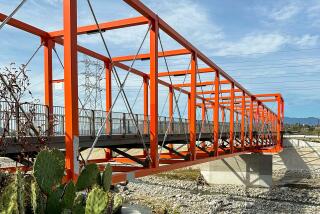The New and Improved Seven Wonders of the World
- Share via
More than two millennia before David Letterman started churning out top 10 lists, a Greek historian named Antipater popularized the world’s most famous top seven list: The Seven Wonders of the Ancient World, compiled in 240 BC.
But six of the seven were lost or destroyed centuries ago--the pyramids of Egypt are the only holdovers--and ever since, travelers, architects, engineers and others have been arguing over which landmarks deserve to be considered modern world wonders. The Eiffel Tower? The Suez Canal? Mt. Rushmore? The L.A. freeway system?
Enter the American Society of Civil Engineers. Joined by Popular Mechanics magazine and aided by various international advisors, the engineers recently unveiled their new favorite septet.
The engineers’ Seven Wonders of the Modern World, detailed in the magazine’s December issue, pierce the sky, hold water or burrow beneath it. All were completed in the 20th century, though at least one was begun in the 19th. Not all are hot-ticket tourist attractions, unless you’re the type to book passage to Paraguay in order to see water being retained. But most of these wonders are familiar landmarks.
Since the engineers limited themselves to this century, the Eiffel Tower (completed in 1889) and Suez Canal (1869) were ineligible. Mt. Rushmore (1941) and the L.A. freeway system (first segment completed in 1943) were eligible, but didn’t make the cut.
In considering candidates, the engineers’ central questions were, “What advances, engineering challenges and long-term significance did each project represent?” Certainly, these judges looked in more corners of the world than did Antipater, whose original wonders were confined to Mediterranean Europe and North Africa. Here are the engineers’ new seven wonders:
1. Itaipu Dam, above the Parana river on the Brazil-Paraguay border. The hydroelectric dam, finished in 1984, is five miles wide. To build it, workers moved 50 million tons of dirt and rock and rerouted the seventh-biggest river on the planet. Estimated cost: $18 billion. The dam inspired modern composer Philip Glass in 1989 to compose a minimalist opera, not a bestseller, titled “Itaipu.”
2. CN Tower, Toronto. Completed in 1976, it stands 1,815 feet high, which makes it the world’s tallest free-standing building. Its entrails include 1,000 tons of cables, the better to facilitate broadcast communications. For $12 per adult, tourists can zoom via high-speed elevator in 58 seconds to an observation deck 1,136 feet up. Also, there is the inevitable revolving restaurant and bar. Hours are 9 a.m.-11 p.m., but in summer months the tower remains open until midnight.
3. The Panama Canal. Completed in 1914 by American efforts after French failure in the late 19th century, the canal joins Atlantic and Pacific oceans, offering shippers one of the world’s greatest shortcuts. Fifty-one miles long and sometimes narrowing to just 110 feet wide, the canal accommodates scores of cruise ships yearly, a few of which cross back and forth every week. Long operated by the United States, the canal is scheduled to revert to Panama in 2000.
4. The Golden Gate Bridge. Built for $27 million in pre-inflation dollars, and christened in 1937. With two 746-foot towers, the Golden Gate is the tallest suspension bridge in the world. Eleven workers died during construction; more than 1,000 people have leaped from it to their deaths. It survived the 1989 Loma Prieta Earthquake with virtually no damage, but now state and federal officials are trembling at the costs of a seismic upgrade to begin this year--up to $1.2 billion.
5. The Channel Tunnel, between Folkestone, England, and Coquelles, France. The 31-mile-long project was completed in 1994 after eight years’ work. Cost: about $15 billion. Instead of flying or taking ferries for the England-France crossing, travelers can ride almost hourly betweenm London and Paris (250 miles) in three hours, or London and Brussels in about three hours and 15 minutes. As March began, Eurostar officials were charging $129-$183 for first-class, one-way, London-Paris passage (depending on departure date and time), or $66-$129 for second class.
6. Netherlands North Sea Protection Works. First, between 1927 and 1932, the Dutch built a 19-mile-long enclosure dam. Then, more than 20 years later, came a network of dams, sluices, canals and dikes, protecting southwest Holland from flooding on the delta of the Meuse and Rhine rivers.
7. Empire State Building. It’s no longer the tallest, or even the second-tallest, building in the United States, but the 1,248-foot Empire did hold that distinction for about four decades. It was built in 410 days, beginning in late 1929, and is estimated to include 10 million bricks, 51 miles of pipe and 17 million feet of telephone wire. Observatories are located on the 86th and 102nd floors. Cost for a ride to the observation decks: $4 for adults, $2 for children ages 5-12, free for children under 5. Open 9:30 a.m. to midnight year-round.
Reynolds travels anonymously at the newspaper’s expense, accepting no special discounts or subsidized trips. To reach him, write Travel Insider, Los Angeles Times, Times Mirror Square, Los Angeles 90053; telephone (213) 237-7845.
More to Read
Sign up for The Wild
We’ll help you find the best places to hike, bike and run, as well as the perfect silent spots for meditation and yoga.
You may occasionally receive promotional content from the Los Angeles Times.







